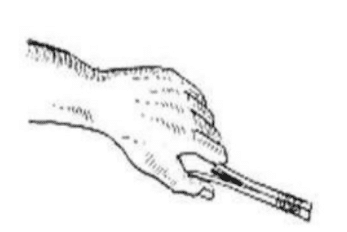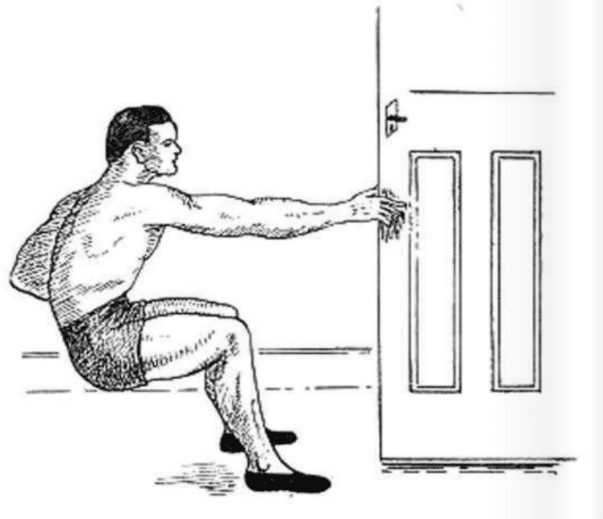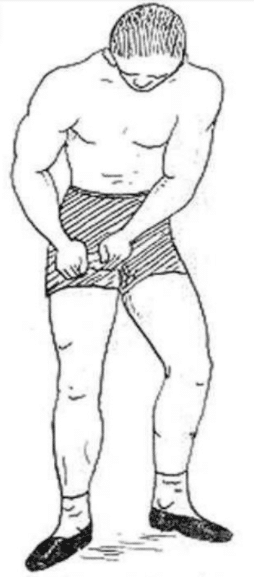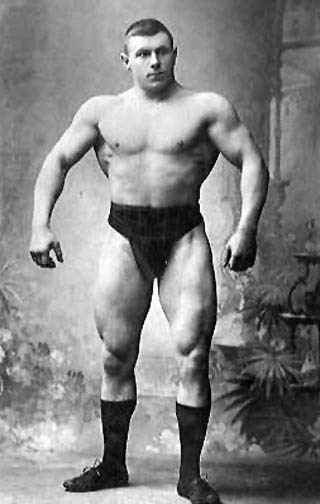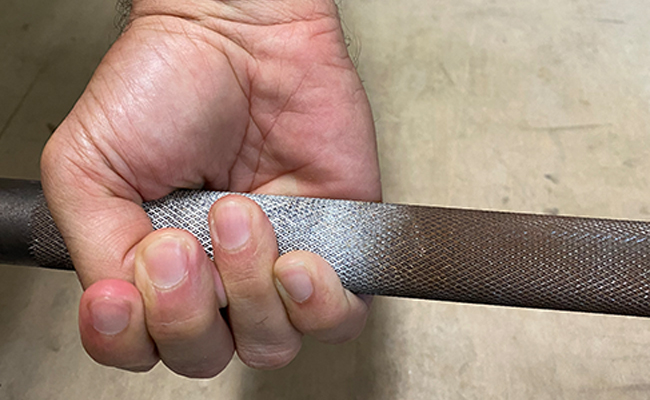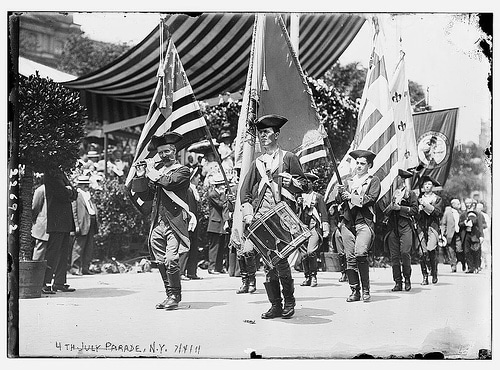Editor’s Note: Edward Aston was a strongman and champion weightlifter in the early 20th century, who held the title of “Britain’s Strongest Man” from 1911-1934. One of the most overlooked secrets to strength, Aston believed, was building one’s grip strength, an aptitude that calls into play not only the hands but all the musculature of the lower arms, from below the elbow to the fingertips. He and his fellow strongmen developed and showcased their grip strength by tearing apart sheets of iron, packs of cards (into both halves and quarters), tennis balls, and phone books (a feat you can learn how to do here). They also awed crowds by bending pennies, nails, and horseshoes, and breaking solid chains. While such displays of grip strength awed crowds, Aston argued that this capacity has a great practical value, not only in improving the ability to lift weights, but enhancing one’s efficiency in performing manual labor, endurance in a crisis, and even overall willpower.
In his short book, How to Develop a Powerful Grip, Aston shares his philosophy on the importance of grip strength and the exercises he and other strongmen used to gain it (accompanied by some sweet illustrations Napoleon Dynamite would approve). Below you’ll find the entirety of the book, condensed from the original.
_____________________
Every one of us today should be interested in the possession of a powerful grip. For the past six years the British nation has been organized for war on a scale unknown to history, with a roll-call of twenty-three and a half millions enlisted in, or working for, the Services out of a total population of forty-two millions; thus representing the greatest national effort among the Allies. This colossal number was engaged in the Army, Navy, Air Force, Merchant Navy, Civil Defense services or on Munitions, many of them having to make full use of their physical powers for the first time in their lives.
No matter whether you were a soldier, sailor, airman, policeman, fireman, air-raid warden or rescue worker, you will agree that the possession of a powerful grip was one of your best physical assets and most of us who served in any of the above capacities are more than grateful because of the service it rendered to us and others.
In those days of enemy action every man or woman could be called upon at any hour of the day or night to use the power of their hands in the work of firefighting or rescue after an air raid. In the field, in the air, on board ship, in the mines, in the factory or even in the streets the possession of a pair of strong arms may have saved your own life or that of your fellow man. Never in the history of our nation was physical fitness so vital to the survival of the race, for every ounce of energy created and utilized in these days of re-habilitation will bring the conquest of peace conditions nearer and this necessary vitality can be created by one method alone: that of physical exercise.
Strength creates confidence, the will to do and dare, the energy and initiative to achieve, to lead where others follow, and most important of all: to carry on when all others have given up. And right behind all this is the exultant confidence in one’s strong right arm that is the main characteristic of the British bull-dog tenacity to hang on.
Now the greatest factor for the creation of a powerful grip is SHEER WILL POWER, for one cannot develop more-than-average strength concentrated in the hands and forearms without one possesses the necessary mental force capable of creating and exerting that power. The man with good gripping powers in invariably a man with a mind of his own, knowing what he requires from life and determined to get it. Hundreds of books have been written on the subject of Will Power, extolling the benefits to be derived from the improvement of this mental trait, while the methods to be used in its creation have been variously prescribed from gazing fixedly at a glass crystal to the act of bending down to touch one’s toes fifty times every morning, but so far as I can remember not one book has advocated the cultivation of the gripping powers of the hand as a means of strengthening one’s character and determination.
Yet we see and hear the connection every day of our lives. A powerful orator is stated to have an excellent grip of his subject and must be able to grip the attention of his audience in order to subordinate their will to his own. The successful student must get a grip of the matter in his text book before he is able to master the subject. The popular author grips the attention of his readers with such power that they have difficulty in closing the book before they have reached the last chapter, no matter what other urgent calls there may be on their time. The prosperous salesman, with his knowledge of practical psychology, must interest his prospective customer in the product, that is to say he must grip his attention before he can create the desire to purchase and so it goes on all through the day, the successful man – and we all have something to sell, if it is only our personality to our friends – must possess “grip.”
Have you ever stood by ashamed of your weakness while stronger men have been able to do the things you would have liked to have done? Perhaps you remember a time when you had to keep in the background and let others come forward to do a real man’s job, not for lack of grit or courage, but because you realized that you did not possess the necessary muscle power to back that courage and you were afraid of the ridicule to which you might expose yourself if you attempted to take a hand? You feared, not the danger, but the possibility of jibes. You strongly desired the cheers and approbation of the crowd but anticipated their derision as you realized how puny your attempts would appear.
This occasion may arise again today or tomorrow, for who can foretell what is in store for us in these stirring times. So prepare now to meet that situation by so training your body that you will look forward to adventure with courage and determination, instead of fear and doubt. To strengthen the wrist and forearm you need no elaborate equipment, for the hands are always in use and consequently the power of grip is very easy to cultivate. No matter where you are, if you have the will to persevere, any article in everyday use will serve for the purpose of developing your grip.
The man in the Services may be apt to imagine that he gets enough work in his daily training to exercise his powers to the full, but a little reflection should convince him that the stronger he becomes the more efficient a soldier, sailor or airman he will make of himself; the better his prospects of promotion and the greater his chance of survival in battle. The policeman, fire-fighter, etc., may feel that he has had enough of it after his spell of duty is finished, but by keeping himself fighting fit, he will undoubtedly possess reserves of strength to cope with any emergency that may arise. Again, the miner, engineer, laborer or even the black-coat worker will work with greater ease and enjoy their recreation more if they take a greater interest in their physical condition.
To exert your gripping powers you have to bring your mental powers into play. You may perform free exercises until the cows come home with little benefit to your health, strength or muscularity if your mind is wandering from the thoughts of breakfast to your best girl, for it is only when you focus your full attention to the muscles being used that the work becomes strenuous and result-getting. Attempt to pick up a weight from the floor – one just within your compass – and you will find that unless you bring your full powers to bear on the job in hand, you will not succeed in raising it an inch. You have to give your full and undivided attention to the task of raising the weight; otherwise you will fail. We therefore see that the practice of exercises calculated to augment one’s gripping powers must of necessity improve and strengthen one’s Power of Will with untold benefits to one’s whole career.
A word of warning to the male. The man who grips your fingers so tightly as to crush them and inflict pain on every occasion for a handshake is in all probability suffering from an inverted inferiority complex and must be tolerated until he realizes his exertion of physical strength is really a display of mental weakness. Therefore, when you encounter this type, resist the temptation to kick his shins and wait for the next occasion, when by seizing his finger-tips – instead of allowing your whole hand to be engulfed by his palm – you can return the compliment. When you have mastered a few of the exercises that follow, your gripping powers will probably be doubled or tripled in strength, but you in your turn will remember that the strong are the gentle and that the athlete’s handshake should be a firm one without undue pressure, creating and imparting a mutual feeling of confidence and friendliness.
Two of the most frequent objections to taking up physical culture that one hears, are, “Oh, Yes, it’s a fine thing, but really I simply haven’t the time,” and “I’m in digs and my landlady would create something awful if I had any gear lying about my room,” to both of which the reply is “Objection over-ruled.” At least as far as the cultivation of extra strength in the wrist and forearm is concerned, for these parts can be exercised whilst walking to work or waiting for a train or bus, without making oneself in the least conspicuous. Nor need there be any set times for practice – unless one wishes to get into the strong man class – for any odd moments can be utilized for practice. Again, for the average person, there need be no apparatus to purchase and therefore no gear to lumber up your digs. The manual worker will find opportunities at every moment to improve his grip when handling the tools of his trade. The clerical worker, whose greatest effort during the day may be the handling of a ledger or the manipulation of a fountain pen, can carry his apparatus about with him in the form of a ball of paper – a small india rubber would be better – in his coat pocket and while awaiting his conveyance, he can alternately grip and relax this small object until his wrists ache. An excellent reminder this will be, that he must keep his shoulders square and his chest out; to offset in some small measure his cramped position over the desk.
Why should the manual worker or the clerk worry about their power of grip? Because it will add a little fun to their work, it will so improve their strength that they will get through their work easier, and, strange but true, they will not be wasting energy but increasing it. Instead of being “all out” at the end of the day, they will be ready to enjoy their leisure, for only by using your muscular power, can you create a reserve of muscular energy.
How to Develop a Powerful Grip
In my considered opinion, a powerful grip is the most important part of the athlete’s physical requirements, particularly so in the case of the weight-lifter, and as a weight-lifter myself it is to this sport that I confine my views. In confirmation of this statement I may recall that some years ago, when the “Two Hands Dead Lift” became popular, those contestants whose gripping powers were inadequate to cope with near-record poundages, were permitted by the rules framed by the Weight-Lifters’ Association to handle the bar in a reverse grip, which allows the lifter to take hold of the bar with one palm facing the front while the other palm faces the rear. This prevents the bar from rolling off the fingers and naturally makes the lifting of the weight much easier from the gripping angle.
Now I contend that when the grip is fully developed this reverse gripping is unnecessary. As proof of this I may be allowed to instance my attempt, in Paris, to raise a weight of approximately five hundred pounds with a bar of two and a quarter inches diameter. This weight, I was told, had only been lifted by three Frenchmen, all of whom were in the heavy-weight class. I was invited to try it and, much to the surprise of the experts present, I succeeded in doing so at the first attempt, and with both palms facing the same way. The reason for my success, can be explained by the fact that in my training for exhibition lifting, I had for years been exercising with a two and a half inch bar, and this had enormously strengthened my powers of grip. As is now well known, the greater the diameter of the bar one practices with, the stronger becomes the power of the hands and forearm. There are other methods to develop a steel-like grip which I propose to describe.
1. SQUEEZING A RUBBER BALL
The squeezing of a rubber ball is excellent practice for the hands and forearms, and will considerably improve the gripping powers of the fingers. Place the ball in the dead center of the hand and circle it with the fingers, keeping the thumb away. Clench the ball tightly, pressing it against the heel of the thumb and then close the thumb on it, turning the wrist inwards slightly. Put some real pressure into the grip and then relax. Continue to grip and relax until the wrist and forearm ache, and then repeat with the other hand. In cold weather a ball may be carried in the overcoat pocket and will provide exercise for the wrists and warmth for the hands.
2. BREAKING MATCH STICKS WITH THE FINGERS
This is not so easy as it looks. Place a match stick of full length between the first and third fingers of one hand, just where the finger nails end. (Not on the nails as shewn in the above illustration.) The second or index finger to be on top of the match, between the two fingers. The thumb and little finger are to be kept free so as to render no assistance in breaking the match. Keeping the fingers perfectly straight, the trick is to break the match by pressing down with the second finger and upwards with the first and third. If one is not successful in this position, the feat can be made easier by shifting the match along the fingers towards the hand. Practice with both hands until proficient. Persons with short fingers have an advantage over those with longer digits. Vansittart, “the man with the iron grip,” could break the stem of a clay pipe in this manner.
3. TWISTING AND TEARING A NEWSPAPER
After you have finished with your newspapers, do not throw them away as they are needed for salvage. But before parting with them you will be able to get some splendid exercise in this manner. Fold up about six papers to a length of nine or more inches, according to their size, and then roll them up in the form of a cylinder. Commence to twist them by turning inwards with the right hand and outwards with the left, the hands being about three inches apart. Continue until they tear. The feat can be made easier by bringing the hands closer together, as the force is concentrated over a smaller area.
4. TURNING JAR TOPS
Procure a long jar with a screw-on lid. Screw the lid on as tightly as can be managed and then proceed to unscrew it. Hold the bottom of the jar in the left hand and the lid in the right, the fingers of which should be well apart. Now securing a firm grip with both hands turn the left hand to the left and the right hand to the right, when the lid should be eased. If it does not turn at the first attempt, simply keep on until it does, as the action brings into play the whole of the tendons of the hands. As the grip improves the lid can be forced on tighter, with greater benefit in the unscrewing process.
5. HOLDING PENNY IN CLOTHES PEG
This is a simple stunt which will test your endurance more than your actual gripping powers. Procure an ordinary clothes peg and placing a coin between the ends, grip the peg over the penny with the thumb and forefinger sufficiently hard enough to retain the coin in position. The test consists in seeing how long you can retain the coin in the peg without relaxing your grip and you may time yourself with the second hand of a watch. Sixty seconds is a very good try.
6. PICKING UP A CHAIR BY THE LEG
The correct method of lifting a chair by the leg is to kneel down on the right knee if the right hand is to be used (or the left knee when the left hand is used), the body being at right angles away from the chair so that an advantage of leverage is obtained. The grip should be taken with the fingers up the leg, the little finger being level with the floor. The elbow should also rest on the floor and the chair raised evenly so that all four legs leave the floor at the same time. If the chair is a heavy one, it will be easier to elevate it by the back leg; although in this case the biceps of the arm will do most of the work instead of the grip. If, even with this added advantage, the feat cannot be accomplished, the hand can be shifted up the leg nearer the seat until it becomes easy. Then, as one’s strength improves, the grip can be taken lower and lower until the bottom of the leg can be utilized. After that, the front leg can be tackled.
7. GRIPPING AN OPEN DOOR
Here is an exercise that will improve the grip in no time. Practice it in this way. Stand before an open door and with the feet level with the edge, grasp the door at waist height with one hand and bend down until you are sitting on your heels and leaning well backwards. Practice this with either hand until it becomes easy. Continue by using the thumb and first three fingers only, then thumb and two fingers, and then just the thumb and first finger. Having reached proficiency with both hands, take up the same position and suddenly drop to the floor as before, catching the door with one hand as you fall. Constant practice will result in a surprising degree of agility and muscular response, particularly so if the dropping back is done with vigor.
8. BENDING A BEER CAP
Another little stunt that looks very easy, but will surprise you. Procure a cap from the top of a beer or mineral water bottle; the kind that are made of tin with corrugated edges and attempt to bend the outer edges until they meet each other. There are several ways to do this. Place the cap in the gap between the thumb and first finger near the hand, or between the top of the thumb and first finger, or as in the illustration, against the folded finger where the clenched fist makes the task somewhat easier, or simply attempt to crush the beer cap in the palm. Try out all these methods and if you do not succeed with any of them, place the cap between the finger and thumb of the right hand, and bringing the aid of the finger and thumb of the left hand to the job, you should be able to accomplish the feat. Removing the piece of cork usually found in the base of the cap will make the task slightly easier.
9. HANGING FROM A ROPE
This is a stunt that can be practiced in any shed, garage or workshop. Secure a short length of stout rope and lie it securely to a hook in a beam over a rafter. Stand on a low stool and reaching up as high as possible, grasp the rope with the right hand, all the fingers being close together. Now hang the whole weight of the body on the rope and kick the stool away. Hang on in this position until the arm is thoroughly tired and then repeat with the left hand. This simple feat should on no account be missed where one has the facilities for practicing it, for it will develop the entire arm and shoulder muscles and add quite considerably to one’s powers of grip. Actually, it is a feat of endurance and therefore no budding strength athlete can afford to miss this opportunity of augmenting his stamina and endurance.
10. TEARING A PACK OF CARDS
One way of tearing the pack is to hold it in the right hand with the palm upwards, thumb round the edges and the right elbow pressed into the side of body for leverage. Take an overhand grip of the top of the pack with the left hand, knuckles upwards, thumb round the opposite edge to the right. Twist the cards one way with the right hand and the other way with the left hand and if your grip is strong enough, they will part in the center. Another way is to place both ends of the pack in the palms, the thumbs being pressed against the index fingers of both hands. In this case the thumbs face in the same direction. Now commence the tear with a twisting motion, the right hand twisting inwards and the left hand twisting outwards. Having secured a start, the twist must be kept going until the pack is halved. With this method it is an advantage if the pack rests on the thigh of the right leg, which should be slightly advanced.
11. PRESSING UP FROM THE FLOOR ON FINGER-TIPS
To develop the grip to its fullest extent, every possible variety of exercise must be utilized, and this one of pressing up from the floor on fingers and thumbs only can be recommended to offset the contractile effect of the usual gripping stunts. Every reader will be familiar with the “Pressup” exercise with the palms of the hands flat on the floor (known in the Services as the “Double Arm Bend and Press.”) but few, I imagine, have tried it out on the fingers and thumbs only. It will be advisable for the novice to practice in the ordinary manner with the hands flat on the floor first, before attempting the more advanced style advocated here. Once a certain degree of proficiency is attained, the fingers and thumbs only should be employed. The idea is to spread the fingers to their fullest extent in order to preserve balance.
12. FINGER LIFTING
There are two methods of lifting weights with the fingers. One is to lift a light weight off a low bench or stool by the contractile power of the finger tendons. In this case, the weight is held in the middle of the second finger joint and the weight raised by curling the finger up to the hand. The other method employs the tensile strength of the fingers to lift fairly joint and the weight raised by curling the finger up to the hand. The other method employs the tensile strength of the fingers to lift fairly heavy weights from the ground and stand erect with them, the lifting finger being curled into a hook and used as such. All the fingers of both hands should be used in turn, and with practice, one can lift almost as heavy a weight as can be raised with the whole hand. It will be best to use a finger-hook, as illustrated on another page, and even then the fingers will be sore after a few attempts and time must be allowed for them to harden.
13. MAKING A FINGER HOOK
If you are desirous of approaching anywhere near to the strong man class, it will be advisable for you to make — or have made for you — a finger hook for lifting. The contractile strength that can be developed in the fingers is little short of remarkable, and the best way to attain that degree of strength is by the regular use of the finger hook. It is quite easily made from aa short length of quarter-inch mild steel, placed in the jaws of a vice and hammered into shape. The loop into which the finger goes is bound with adhesive tape in order to protect the finger. Each finger should be used in turn with gradually increasing weights. With practice, the middle finger should be able to raise within twenty percent, of that elevated by the entire hand.
14. HOLDING OUT A BROOM WITH FLATIR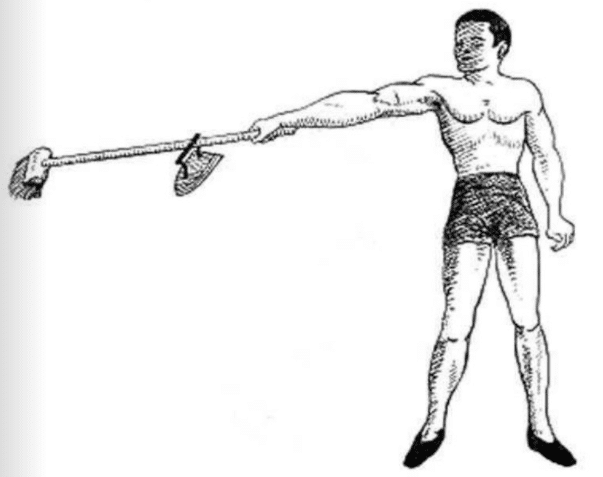 ON
ON
To hold out a heavy bass broom by the further end of the stick is quite a feat of its own for the average man, but as this type of broom is not always available, the ordinary house broom will have to be utilized, and this utensil being of light weight should prove to be well within one’s powers. To make the feat worthwhile, a flat-iron may be threaded on the handle and an attempt made to ascertain one’s strength by the measure of distance the iron is from the hand. Once this is done, the position should be marked and practice put in by gradually shifting the iron towards the broom end. The grip should be taken near the end of the stick with the knuckles upward, the thumb being well underneath and spread along the handle.
15. TEARING A TELEPHONE BOOK
One way to accomplish this feat is to hold the book with the bound edge resting on the thigh, both hands grasping the leaf edge with the knuckles upwards, back of both hands facing the body. The thumbs should be about two inches apart. Now double the book on itself, causing the leaves to spray and then start the tear by pulling towards the body with the right hand and pushing away with the left hand. Continue to push and pull until the whole of the sprayed pages are started. It will now be an easy matter to complete the halving of the book. This method of starting the tear with a few pages is by far the easiest and although the trick – for trick it really is – may be obvious to many of the audience, speed will come with practice and then the tear will appear so continuous that the book will seem to be halved at one operation. The fairest method is to tear the book from the back – that is, the bound edge – for as it presents a solid edge it becomes a real feat of strength.
16. CIRCLING A DUMBBELL
This is an exceptionally good exercise for the whole of the wrists. Sit on a chair, with the elbow of the right arm resting on a table, and grasp a round-headed dumb-bell by one end, with the fingers well-spaced around the ball. Work the wrist and roll the dumb-bell around in a circle, allowing the further end to describe the fullest possible arc. Revolve the dumb-bell first to the right and then to the left. When the wrist of the right hand begins to tire, change over to the left hand.
17. HOLDING OUT A DISC ON A ROD
Here is a feat for the barbell fans. It consists of holding out a dumbbell rod on which a disc is held in position by a collar, or collars, and must not be confused with the lift known as the “crucifix” or “muscling out,” as it is termed in the States. Place disc of, say, ten pounds on an eighteen inch rod and secure it in position near the center with a collar at the rear on both ends. Grasp the rod firmly in the right hand, allowing the little finger to be level with the end of the rod. (In the illustration the grip is taken too far along the bar.) If you can manage the weight, try it out with the left hand, if not, bring the disc in toward the hand a little. Continue to practice as opportunity occurs until the weight can be taken to the far end of the rod. In “muscling out” the strain is on the shoulder and upper arm, but this feat is a real teaser for the forearm and grip.
18. PICKING UP DISCS
Here is another feat for the barbell fans. It consists of the simple action of picking up a heavy disc by the forceps-like grip of the thumb and fingers. Stand the disc on edge and spreading the thumb well down the sides of the plate, pick it up from the ground and stand erect. These dishes are made in various weights, and one should commence with a 25 lb. disc. Secure a good pincer grip and then lift with the shoulder of the arm in use, for you may find that if you attempt to lift the weight by bending the forearm, the discs may escape your hold. Therefore take a grip and stand up, keeping the lifting arm perfectly straight.
19. HOLDING OUT DISCS
Here is a slight variation on the holding-out feats. The disc is held out at right angles to the body with the plate resting on the spread fingers and kept from toppling over by the pressure of the thumb only. It will be found that the strain is centered on the first and second joints of the fingers and the ball of the thumb. A 10 lb. plate can be used to commence, and you will find that a good deal of practice is necessary before the next size discs can be managed, for the 15 lb. plate has a larger diameter and this means that the strain on the hand is increased out of all proportion to the actual weight. Much will therefore depend on the make of the discs; whether they are of the squat type , or having a wider diameter.
20. CIRCLING A BARBELL
This is a rather similar movement to that of winding up a weight, for the muscular action is the same, except that one retains the same grip on the bar all the time. The barbell is brought up from the “hang” position, to the front of the body, with the knuckles upwards. It is permissible to dig the elbows into the sides so that the action may be concentrated on the wrists and forearms. Keeping the arms rigid, turn the hands upwards and downwards to their fullest extent by wrist action, retaining a full grip on the bar all the time.
I have often marveled that weight-lifters, as a rule, do not pay more attention to the grip. There appears to be no limitation to the height to which the fully developed grip of the human hands could be trained, and its full potentialities must be enormous. I am fully convinced that at least another twenty percent could be added to the poundage of some of the lifts if the lifter’s grip was more carefully cultivated. Take any lift of a heavy poundage and you will find lifters who are able to “jerk” more than they can “clean.” This should not be so. I was addicted to this failure myself, through not sufficiently cultivating my extreme possibilities of grip power. I could jerk three hundred and thirteen pounds but was only able to clean two hundred and eighty pounds. Of course, I can excuse myself now and say that this was a long time ago, but I should have known better. Any lifter should be able to clean a weight up to jerking possibilities and the failure to do so is only insufficient gripping powers, for the other muscles are strong enough to accomplish the lift. In the “two hands snatch” we have a lift capable of a very high poundage, but the lifter often fails to record his best owing to lack of grip. As an observer of athletics to-day, instead of an active participant, I can see how success can be greatly advanced by means of developing one’s powers of grip to its absolute maximum. My advice, to all would-be champions is, make sure that you develop a powerful grip.
Tags: Exercises






